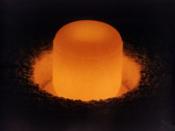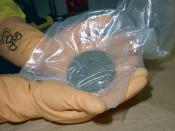Plutonium
Plutonium is a radioactive metallic element. Although it is occasionally found in nature, mostly all of our plutonium is produced artificially in a lab. The official chemical symbol for plutonium is Pu, coming from its first and third letters. Its atomic number is ninety-four. Plutonium is able to maintain its solid state until very high temperatures, melting at six hundred and forty degrees Celsius, and boiling at three thousand four hundred and sixty degrees. The density of Plutonium, at twenty degrees centigrade, is 19.86 grams per cubic centimeter.
Plutonium was discovered, in the laboratory, by Glenn Theodore Seaborg, and his associate Edward M. McMillan. The two shared the Nobel prize in 1951 for their discoveries of Plutonium, Americium (Am), Curium (Cm), Berkelium (Bk), and Californium (Cf). In addition, Seaborg later contributed to the discovery of three more radioactive elements, Einsteinium (Es), Mendelevium (Md), and Nobelium (No).
Plutonium was Seaborg's first discovery. Its name came from Pluto, the planet after Neptune for which Neptunium was named. In 1940, at the University of California at Berkeley, he bombarded a sample of Uranium with deuterons, the nuclei in atoms of deuterium, transmuting it into plutonium. Shortly after, Seaborg was able to isolate plutonium 239, an isotope used in atomic bombs.
Plutonium is a highly dangerous and poisonous element because it rapidly gives off radiation in the form of alpha particles. Alpha particles, which are identical to the nucleus of a helium atom, consist of two protons and two neutrons tightly bound together. Although the particles can only travel about five centimeters in the air, they can cause great damage when the enter the body, causing cancer and other serious health problems. Beyond the danger of their radiation, Plutonium will spontaneously explode when a certain amount, called critical mass, is...


